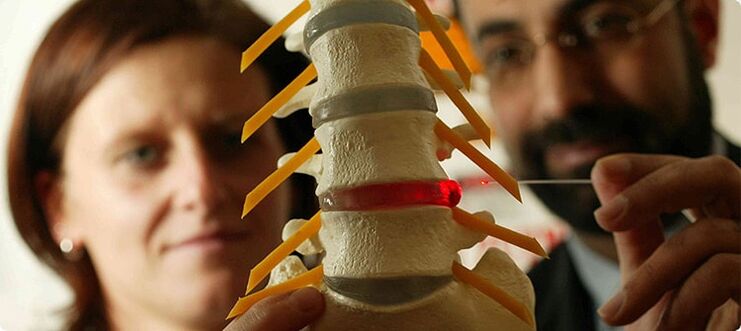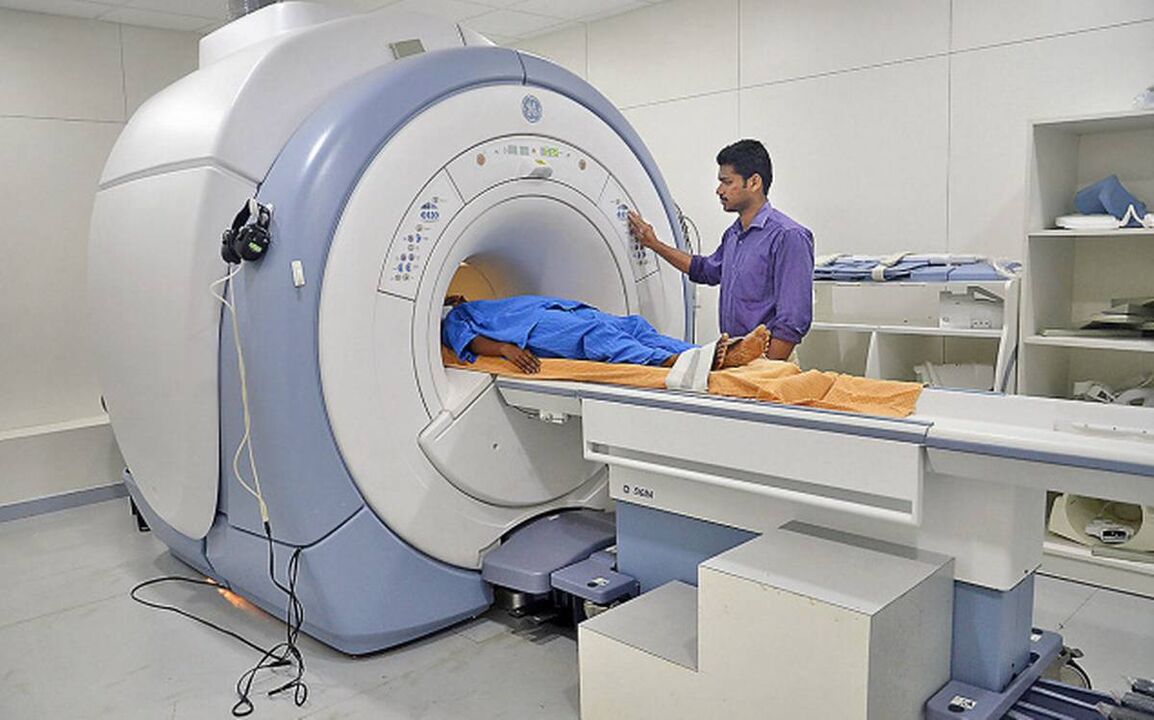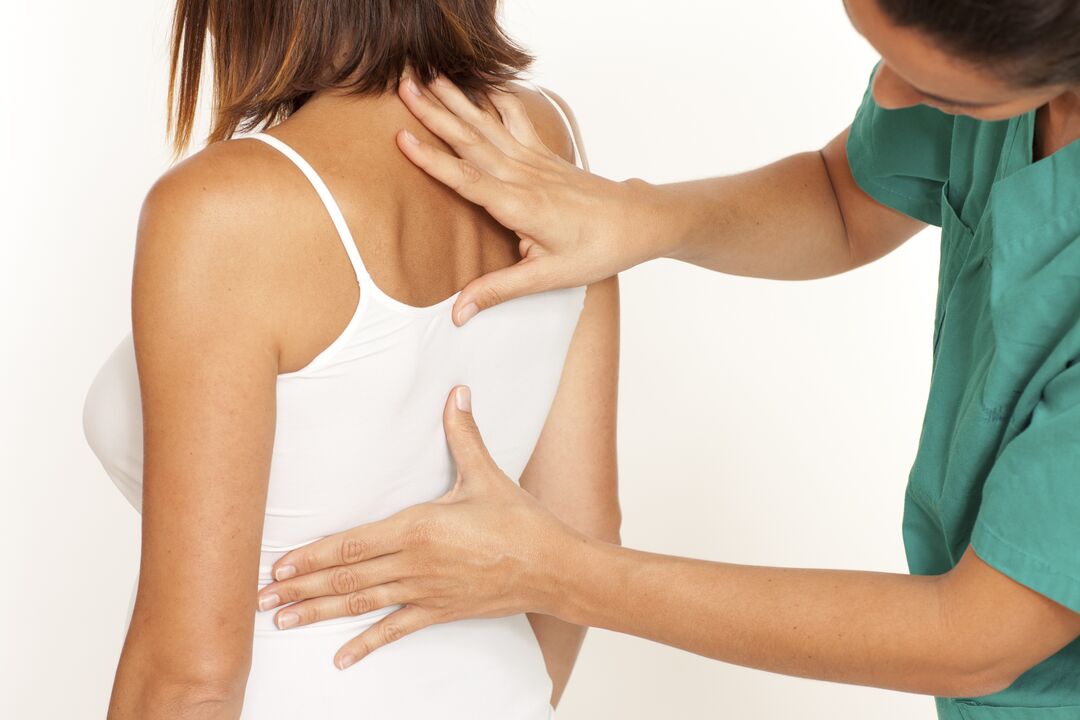The symptoms of thoracic osteochondrosis depend on which vertebrae have suffered dystrophic lesions and their intensity depends on what changes have occurred in it. An experienced specialist, after hearing the patient's complaints, will be able to make a correct diagnosis and point out which part of the spine has undergone serious change and destruction. The sooner a doctor diagnoses osteochondrosis of the chest and prescribes medication, the sooner relief will come.
Chest osteochondrosis is much less common than cervical osteochondrosis because the thoracic spine is less susceptible to stress and deformation. But, nonetheless, it causes a lot of pain and discomfort and has a variety of symptoms.

Chest osteochondrosis, symptoms and signs
The pain is localized mainly between the shoulder blades or in the intercostal space. Often chest osteochondrosis manifests itself in the form of belt pain in the ribs of the body. Patients describe such pain as a "cutting in the chest" feeling that their mobility is impaired because the pain is met with the slightest careless movement. Because it causes sharp and severe pain. Incomfort also causes body vibration, i. e. riding a bicycle, driving on rough road, as well as any jumps. Cooling the body can aggravate the pain, even with proper treatment, the disease can start with renewed energy.
Often the pain is localized in the spaces between the ribs. It is caused by compression of the nerve roots, leading to intercostal neuralgia. The sensation of pain intensifies at night, when turning from side to side or when changing posture, the patient wakes up from sharp penetrating pain, even despite treatment with painkillers.
Sweating, fatigue, and rapid fatigue are associated with signs of pain, sometimes with a rise in temperature on the inflamed segment of the spine.

Signs of Dorsago and Dorsalgia
Severe and very sharp pain is called dorsago. Dorsago symptoms in thoracic osteochondrosis are seen in people who sit for long periods of time in a prone position. With a sharp lift or change of position the body aches sharply. He is so strong and sudden that you lose your breath and find it difficult to breathe. The muscles of the chest and spine become stone-like, sometimes digging with convulsions. The treatment relieves the pain and relieves the patient.
Dorsalgia, on the other hand, is a pain of a painful nature. It's not very intense, but it constantly reminds me of myself. With sudden and rapid movements, coughing, wheezing, or deep inspiration, the body also experiences severe lightning pain. Body curvature and inclination are also given with difficulty and pain. The muscles of the back and chest are tense and the feeling of as if the upper part of the body is tied with a belt prevails.
To relieve or temporarily alleviate the condition from these pains, sometimes it is enough to walk or do light exercise.
Signs of a neurological nature during osteochondrosis
The most common manifestations are osteochondrosis of the chest segment, symptoms of a neurological nature. This is manifested by a "goose" or loss of sensation in the abdomen or upper chest. Occasionally, patients experience tension or tension in the muscles of the spine, mainly in the upper part, as well as in the chest.
Chest osteochondrosis is almost the same in men and women and the symptoms are similar. The only difference is that women have a further manifestation of the disease. Women are prone to this disease during menopause. This is caused by a decrease in the hormone progesterone, which protects the spine, or rather the spinal discs, from wear and tear.
A woman with osteochondrosis may have strange symptoms such as flaking of the skin and brittle nails. Women find it more difficult to tolerate osteochondrosis of both the chest and cervix, this is caused by a low-pain defect of the weaker sex.
Men, on the other hand, turn to specialists in osteochondrosis of the chest more often than women, and the average age is about 30-40 years. Men can complain of impaired potency. The most important thing here is to acknowledge the doctor about the intimate problem and not treat it yourself.
Signs of osteochondrosis that can be confused with other diseases
Since there are many nerve fibers and extremities in the chest area, the back pain of the chest can radiate in any direction. The symptoms of osteochondrosis are very similar to the symptoms of other diseases, which complicates the diagnosis. Early diagnosis and treatment of osteochondrosis is very important for a more favorable outcome of the disease.
Many people confuse osteochondrosis with heart disease. But here it is worth remembering some differences. First, pain in chest osteochondrosis is longer lasting and cannot be treated with heart medication. And the second sign is an increase in blood pressure, as it often happens in diseases of the cardiovascular system. And most importantly, the ECG results do not show any abnormalities in the work of the heart.
In women, pain can spread to the mammary glands and this sign of chest osteochondrosis is very common. In this situation it is necessary to consult a mammologist and rule out breast disease.
Sometimes the patient complains of pain in the epigastric area, which may be confused with gastritis or gastric ulcer. The pain may also be localized to the right hypochondrium, and unqualified medical staff may suspect cholecystitis or pancreatitis. Appendicitis may be suspected during pain in the lower abdomen. In such cases, it is advisable to conduct additional ultrasound examination of the abdominal organs, gastric X-ray and EGD, and, of course, clinical blood tests.
If the lower part of the thoracic spine is damaged, the patient will have signs of intestinal disease. But this condition is not dependent on food intake and the pain is intensified by physical exertion.

If osteochondrosis affects the upper part of the spine, then the pain will spread to the pharynx and esophagus. The patient will feel a sign of a foreign body in the feed and may find it difficult to swallow food, especially poorly digested food.
Diagnosis and treatment should be decided only by a doctor, self-medication in this case is unacceptable.
Influence of profession on the development of osteochondrosis
The specifics of some professions can lead to the development of osteochondrosis. This is caused by a sedentary lifestyle, especially in professions such as trucks, pilots, drivers. And also in the risk group are professions related to lifting weights, for example, loaders. Prolonged lifting and carrying of large loads causes the spine to be crushed and flattened, which also causes osteochondrosis of not only the chest but also the cervical and lumbar segments of the spine. In more advanced cases, the hands or back begin to numb around the shoulder blades. This is an awakening call to a specialist for examination and treatment.
Most office workers are prone to cervical osteochondrosis. That is, not only the chest area but also the cervical vertebrae are involved in the process of change and destruction. Due to prolonged sitting at the computer and even in the wrong posture, it causes weakening and darkening of the supporting muscles of the spine. The vertebrae begin to shift, thus stretching the nerves.
Also, when immobile in one posture, the blood circulation of the intervertebral discs is disrupted, leading to starvation of the disc tissues and their destruction. They experience pain in the head, shoulders and chest. They have hearing loss and tinnitus. With an abrupt lifting or movement of the head, the employee may lose consciousness as the work of the vestibular apparatus is disrupted. Sight is often impaired and flies appear in front of the eyes. The muscles of the shoulder girdle and chest ache as after a long workout.
It happens that after treatment it is worth changing professions as there are frequent relapses in the old workplace.































